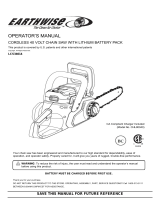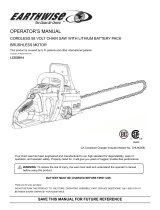- cutting in conditions where the trunk could split during
cutting (wood under pressure, dry dead trees, etc):
sudden splitting can be very dangerous.
- the bar or the chain from becoming blocked in the
cutting notch: if this should occur, disconnect the
machine from the main electricity supply and try to
raise the trunk using an appropriate tool as a lever; do
not attempt to free the machine by shaking or pulling as
this could cause damage or injury.
- situations that can lead to kickback reactions.
- using the product above shoulder height
- cutting wood with foreign objects e.g. nails
- When cutting on sloping ground, always work uphill of the
trunk to avoid being hit if the trunk should roll downhill.
- When felling trees, always finish the job: a partially cut
tree could break and fall.
- At the end of each cutting operation the user will
notice a considerable change in the strength necessary
for controlling the machine. Great care must be taken
not to loose control. Below is a description of two
different types of cutting operation:
Cutting action by pulling the chain (from top to bottom)
can lead to dangerous sudden movement of the
machine towards the trunk with consequential loss of
control. Where possible, use the spiked bumper during
cutting operations.
Cutting action pushing the chain (from bottom to top)
will lead to the danger of a sudden movement of
the machine in the direction of the user, with the risk of
hitting the user, or an impact of the “kickback danger
zone” on the trunk resulting in strong kickback; extreme
care must be taken when cutting in this manner.
The safest method for using the machine, is to block
the log on a sawhorse, cutting from top to bottom, on
the portion outside the sawhorse.
Where possible, use the spiked bumper to ensure safer
cutting action: plant it in the bark or surface of the trunk
in order to maintain more control over the machine.
Below are descriptions of typical cutting procedure to
be adopted for specific situations. However, these
should be assessed each time to calculate whether the
method is most suitable or not, In order to use a
method with the least possible risk.
(Risk of touching the ground with the
chain once the bar has passed trough the trunk).
Cut from top to bottom through the whole trunk. Towards
the end of the cut, proceed very carefully to prevent the
chain from hitting the ground. If it is possible, cut 2/3 of the
trunk, roll it over, and cut the remaining third from top to
bottom to limit the risk of the chain touching the ground.
Trunk supported at one end only (Risk of trunk breaking
during cutting action).
Begin the cut from underneath for about 1/3 of the
diameter, and then finish the cutting action from the top
to meet the undercut.
Trunk supported at both ends. (Risk of pinching the
chain).
Begin the cut from above for about 1/3 of the diameter,
and then continue from underneath to meet the overcut.
Always stand on the uphill
side of the log. When ‘cutting through’, to maintain
complete control, release the cutting pressure near the
end of the cut without relaxing your grip on the chainsaw
handles. Do not let the chain contact the ground.
Never attempt to fell a tree if you do not
have the necessary experience, and in any case never
fell trees that have trunks with a diameter larger than
the length of the bar! This operation is reserved for
expert machine users with adequate equipment.
When felling a tree, the aim is to have the tree fall in the
most convenient position for the following limbing and
bucking operations. (Avoid trees falling on top of other
trees: Felling trees that are entangled with other trees
is a very dangerous operation).
First of all decide which is the best direction for the tree
to fall by evaluating the following: objects or other plants
around the tree, the inclination, the curve, wind
direction, and greatest branch concentration. Take into
account dead or broken branches that may break off
during felling creating a further danger risk.
During tree felling operations in critical
conditions, always remove ear protection immediately
after cutting operations to be able to listen for unusual
noises and any warning signals.
Eliminate any branches that interfere with the job (fig.8),
starting from top to bottom, and then, always keeping
the trunk between the user and the machine eliminate
the more difficult branches afterwards, piece by piece.
Eliminate all plants that interfere with work operations
and control the area for possible obstacles (rocks,
roots, ditches,etc.) when planning the retreat path (to
follow during tree fall); Refer to the illustration (fig.9) for
the directions to be maintained (A. predicted tree fall
direction. B. Retreat path. C. Danger zone).
In order to ensure that the user has complete control over
the tree fall, the cutting instructions are as follows:
The cut that controls the fall direction of the tree is to be
executed first: First of all cut the UPPER PART of the
directional notch on the side the tree must fall. Remain on
the right hand side of the tree and cut using the chain pull
method; then cut the LOWER PART that must meet the
end of the upper part. The depth of the directional notch
must be
1/
4
of the trunk diameter, with an angle of at least
45° between upper and lower cut. The meeting point
between the two sides of the notch is called “directional
cut line” This line must be perfectly horizontal at right
angles (90°) to the felling direction.
The felling cut that provokes the tree fall, is performed at 3
to 5cm above the lower part of the directional felling cut
line, finishing at a distance of 1/10 of the trunk from the
notch. Remain on the left hand side of the tree and cut
using the chain pulling method and the spiked bumper.
Check that the tree does not move in a direction other
than that predicted for the fall. As soon as possible
insert a felling lever or wedge into the cut. The uncut
part of the trunk is called the “hinge”, as it is intended to
guide the tree as it falls; in cases where the cuts are not
sufficient, not straight, or have been cut through
completely, the tree fall cannot be controlled (extremely
dangerous!). For this reason the various cuts must be
performed with great precision.
When cutting operations are completed the tree will
begin to fall. Where necessary help tree fall using
wedges or felling levers.
Once the tree has been felled, the trunk must be
limbed: in other words, the branches are removed from
the trunk. Do not underestimate this operation because
the large majority of kickback accidents occur during
this stage. For this reason pay close attention to the
position of the bar nose during cutting operations and
always work on the left hand side of the trunk.





















